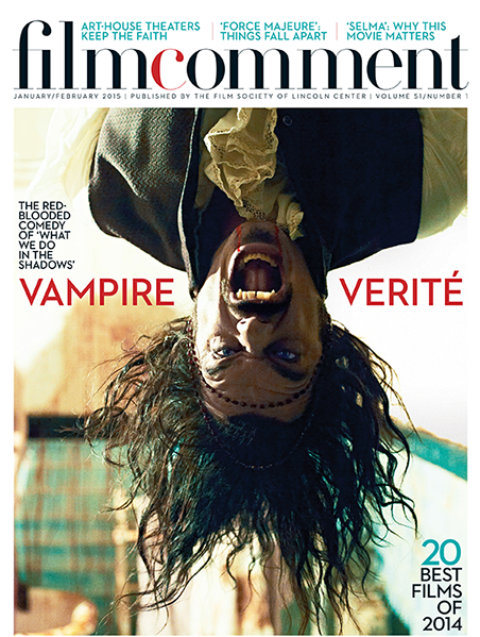Three of the most widely seen screen characters in the past year were digital creations within a mostly live-action environment: Caesar in Dawn of the Planet of the Apes and scene-stealers Groot and Rocket Raccoon from Guardians of the Galaxy. Even if you don’t include these films or others that depend on digital effects such as Jonathan Glazer’s Under the Skin, or the number of recent documentaries with animated sequences, such as Edet Belzberg’s Watchers of the Sky, you can make a case that 2014 represents the strongest slate of animated features ever released domestically in a single year. Thanks to New York–based distributor GKIDS, it’s now a given that we will be able to see superior animated films from around the world, and the past year’s trio of The Boy and the World, The Tale of the Princess Kaguya, and Song of the Sea are among the best ever released by the company. But what was especially exciting about the past year was the number of terrific films from American studios. It’s the rare animated feature that enjoys mass appeal among children and doesn’t grate on adult audience tastes, but there were a fistful to choose from in 2014. My one regret in compiling this list is that I didn’t have a chance to catch up with Bill Plympton’s latest, Cheatin’.

Big Hero 6
Don Hall & Chris Williams
Perhaps no studio-produced animated feature felt so of its time as Disney’s Big Hero 6. Loosely adapted from a Marvel comic, it’s set in “San Fransokyo,” and features a teen tech whiz named Hiro, his robot sidekick Baymax, and a diverse “hero” group that works to stop a rogue scientist from using one of Hiro’s inventions for criminal purposes. Stunning animation, and an encouraging hint of things to come from the Disney-Marvel merger.

The Boxtrolls
Graham Annable & Anthony Stacchi
Based in Oregon, the animation outfit Laika is known for its inspired stop-motion films, and considering its first three features—Coraline (09), ParaNorman (12), and The Boxtrolls—it won’t be long before the studio becomes a brand like Pixar. The Boxtrolls has all of the elements of an enduring kid’s classic. Its tale of a small quasi-British town plagued by a demonized and misunderstood subculture of otherwise harmless trolls is silly, creepy, and above all hilarious. The post-credits sequence showing the stop-motion animators in action is a must-see for kids and adults alike.

The Boy and the World
Alê Abreu
This Brazilian animation presents a series of environments and characters that might have been designed by Joan Miró. The simple story concerns a country boy who leaves home to follow his father, who has left for the city in search of work. Abreu manages to preserve his protagonist’s wide-eyed wonder during his journey while illustrating the sharp contrasts between city and country life, the working class and the capitalist elite, and Brazil’s past and imagined future.

The LEGO Movie
Phil Lord & Christopher Miller
Despite the lingering disbelief that a studio-produced, kid-oriented animated feature might actually be biting the numerous corporate hands that feed it, The LEGO Movie won over a sizable contingent of critics. What to do with a corporation (Lego) and a mainstream film that might actually be promoting individuality and creativity?

Let Your Light Shine
Jodie Mack
Experimental filmmaker Jodie Mack’s largely found-object films often stray back and forth across the boundary that separates animation from other visual disciplines. Few films shorter than three minutes leave the viewer searching for words, but simple line animation in Let Your Light Shine (also the title of Mack’s touring program) creates a dazzling and immersive expanded cinema experience with the aid of prismatic glasses that are distributed to the audience before the film. Dusty Stacks of Mom uses her mother’s defunct poster business as a backdrop and its pop-culture bounty as the material for her stop-motion featurette which, in exhibition, is often accompanied by the filmmaker’s karaoke take on Pink Floyd’s Dark Side of the Moon with alternative lyrics composed by Mack. It is Mack’s longest work to date.

Rocks in My Pockets
Signe Baumane
Rocks in My Pockets traces its Latvian filmmaker’s family history of coping with depression and suicide. Baumane’s visual style is reminiscent of that of Bill Plympton (he’s thanked in the credits) and her film is a perfect example of animation’s unique ability to visualize interiority while telling compelling stories far removed from children’s idiom.

Song of the Sea
Tomm Moore
From the director of The Secret of Kells (09), Song of the Sea is an enchanting fantasy from Ireland about a boy and his mute sister and the family secret that the two uncover as they are moved from the lighthouse where they grew up after the presumed death of their mother. The design of the film is simply gorgeous, evoking the work Mary Blair did for Disney in the Fifties.

The Tale of the Princess Kaguya
Isao Takahata
Something of a tonal departure from the Studio Ghibli co-founder, this classical fantasy follows a bamboo cutter who finds a tiny and obviously magical girl in the forest and raises her as she grows—rapidly—into a beautiful young woman who receives the title of “princess” from a local priest and the affections of high-ranking suitors. Takahata’s animation is elegant and admirably restrained. It is a rare example of an animated feature that emphasizes character development over narrative short cuts in search of cheap laughs or the kind of maudlin sentiment that’s calibrated to strike a chord with only the youngest viewers.








